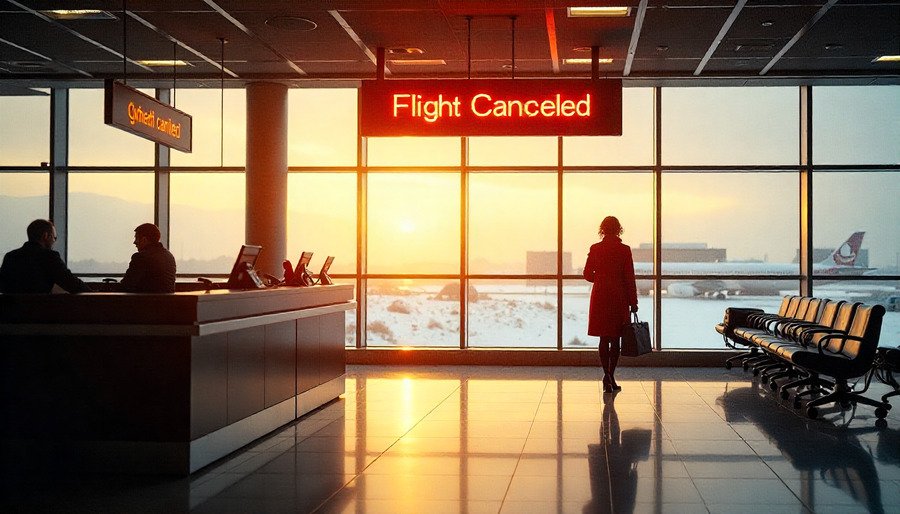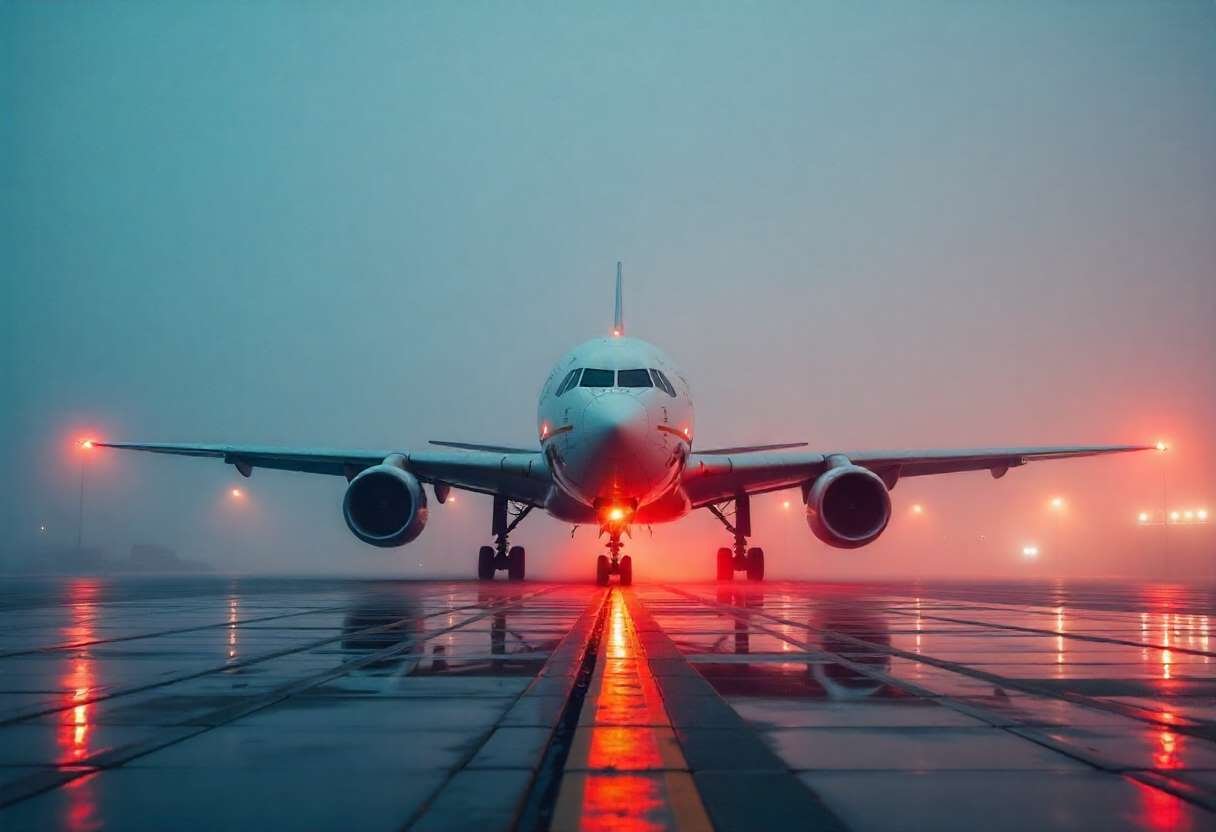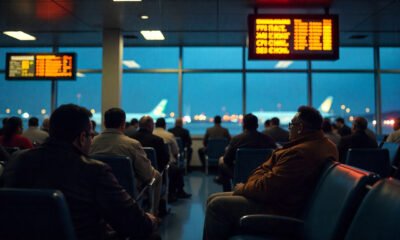Flight Buzz
More Than 250 Flights Canceled Across US as Southwest, Delta, United, American, JetBlue, and More Face Severe Travel Disruptions at Chicago, DFW, JFK, and LaGuardia

Sunday, July 27, 2025
More than 250 flights were canceled nationwide at major U.S. airports yesterday, as Southwest, Delta, United, American, JetBlue and other airlines grappled with massive delays because of the imminent severe weather, such as severe thunderstorms and flash flooding. Chicago O’Hare, Dallas-Fort Worth (DFW), John F. Kennedy (JFK) and LaGuardia are among the airports most affected, and the delays and cancellations are likely to continue as the storm system moves east. The weather disruptions, which included powerful winds and drenching rain, created disruptions before the worst of the storm had even taken hold, interrupting travel plans and flight schedules across the country.
At Chicago O’Hare and Midway, Southwest Airlines canceled 45 flights and delayed 73 others, with United and Delta also reporting significant delays. JFK International saw 36 cancellations, with Delta, JetBlue, and Lufthansa being among the most affected, while LaGuardia experienced 25 cancellations, particularly impacting Delta and Republic Airlines. Dallas-Fort Worth (DFW) had 7 cancellations, mostly affecting American Airlines, though delays were reported throughout the airport. Many flights from other carriers like United, Air Canada, and JetBlue were also delayed across these hubs. As the storm system moves eastward, further disruptions are expected, particularly in the Northeast and Midwest.
Severe weather caused major disruptions across U.S. airports, with airlines such as Southwest, Delta, United, American, and JetBlue reporting widespread delays and cancellations due to storms, flash floods, and high winds. The storms primarily affected airports in Chicago, Dallas-Fort Worth, JFK, and LaGuardia, and disruptions were felt throughout the day.
Southwest and United Airlines Hit Hard at Chicago Airports
Chicago O’Hare and Midway saw the highest number of cancellations, with Southwest Airlines canceling 45 flights and delaying 73. United and Delta also reported significant delays, while American Airlines faced cancellations due to the weather, which included flash floods and strong winds.
Severe Disruptions at JFK and LaGuardia
At JFK, 36 flights were canceled, mainly affecting Delta, JetBlue, and Lufthansa. LaGuardia also faced 25 cancellations, impacting Delta and Republic Airlines, as well as other carriers like American Airlines and Southwest, resulting in long delays.
DFW Faces Fewer Cancellations, But Delays Still Impact Travel
Dallas-Fort Worth reported 7 cancellations, primarily affecting American Airlines. Though not as severely impacted as East Coast airports, DFW still experienced delays due to the ripple effects of the storms.
Delays Across the U.S. as Weather System Moves Eastward
Along with the cancellations, flights from airlines like United, Air Canada, JetBlue, and American were delayed across the U.S. The storm system is expected to continue causing disruptions, particularly across the Midwest and Northeast as it moves eastward into the weekend.
More than 250 flights were canceled across major U.S. airports yesterday as Southwest, Delta, United, American, JetBlue, and other airlines faced significant disruptions due to severe weather conditions, including thunderstorms and flash flooding. Key airports like Chicago O’Hare, DFW, JFK, and LaGuardia were particularly impacted, with delays and cancellations expected to continue as the storm system moves eastward.
Travelers Advised to Stay Informed Amid Ongoing Weather Threats
As the severe weather system continues to affect air travel, travelers are urged to stay informed by checking flight statuses and consulting airlines for rebooking options. The storms are expected to affect more airports in the coming days, and with the busy summer travel season, passengers should be prepared for further cancellations and delays
Flight Buzz
Moscow Pyongyang Flights Resume After Three Decades

Sunday, July 27, 2025
Russia is preparing to resume direct passenger flights between Moscow and Pyongyang, after thirty years. This historic resumption reflects an intensifying strategic alliance and may subtly influence regional transit flows in Southeast Asia including travel patterns involving Thailand.
Government-Confirmed Flight Approval
The Ministry of Transport of the Russian Federation officially announced that flights will commence on July 27, 2025. The flights will operate monthly initially, with possible expansion to twice weekly based on demand. The aircraft is expected to be a Boeing 777‑200ER with a seating capacity of 440 passengers for the eight‑hour journey.
Russia’s civil aviation authority Rosaviatsia granted permission to Nordwind Airlines to operate the route. The transport ministry confirmed that, although monthly at first, the flights are designed to build demand before increasing frequency.
Rail Revival and Broader Transport Links
Complementing the flight resumption, Russian Railways restored an eight-day passenger train service between Moscow and Pyongyang, making it one of the longest direct train journeys in the world. This rail link complements air travel, symbolizing deepening transport integration.
Strategic and Diplomatic Context
These developments come against the backdrop of Russia-North Korea rapprochement under a Comprehensive Strategic Partnership Treaty signed in June 2024, which enshrined cooperation across political, security, and cultural domains . Russia’s Security Council Secretary Sergei Shoigu confirmed at a Moscow press briefing that regular flights will resume after more than three decades of absence.
Implications for Regional Transit and Tourism
Although the route links two distant capitals, the ripples extend into Southeast Asia. Thailand’s tourism industry—particularly its gateways like Bangkok, Phuket, and Chiang Mai—often depends on connecting traffic through transit hubs like Doha, Dubai, Singapore, Kuala Lumpur, and even European nodes. While Russia–North Korea flights may not directly involve Thailand, shifts in global aviation networks can influence how multi‑leg itineraries are planned.
Thailand’s tourism authorities have previously observed that diversions or new routes in distant regions may shift traffic away from traditional stopover cities in Asia. For example, Russian or DPRK tourists may adjust global routing in future itineraries, subtly influencing inbound flows in Thailand via alternate hubs.
Human Angle: Enhancing Connectivity, Easing Barriers
For ordinary travellers—especially Russian citizens—it means new access to North Korea without relying on indirect transit via Vladivostok or charter flights. For tourism boards and travel agents, increasing route options signals changing planning needs. Across thousands of kilometers, the tourism ecosystem—including Thailand’s inbound segment—must stay alert to shifts that affect connection choices for Asian and Russian tourists.
Looking Ahead: Growth and Monitoring
As Nordwind Airlines builds up passenger frequency, Russian and North Korean transport authorities will evaluate demand. If flights become bimonthly or weekly, more regular logistics and visa facilitation could follow.
Thailand’s Tourism Authority and Ministry of Tourism & Sports will closely monitor these developments. If Russia–North Korea connectivity increases, travel patterns—especially those involving Russian tourists touring Asia—might reconfigure itineraries and stopover flows that skirt traditional Southeast Asian nodes.
Conclusion
In simple terms: Russia is restarting direct Moscow–Pyongyang passenger flights on July 27, 2025, after a break of over three decades. The move is part of deepening strategic ties and broader transport reintegration. Though Thailand isn’t a direct destination, its tourism sector may feel subtle shifts via global transit realignments as travel routes evolve. For everyday travellers and global tourism planners alike, this marks a significant shift in cross-border connectivity.
Flight Buzz
Batik Air Ends Kuala Lumpur–Amritsar Flights

Sunday, July 27, 2025
Batik Air Malaysia has officially terminated its Kuala Lumpur–Amritsar service. As part of broader safety-driven route restructuring, the airline is also adjusting flight operations which may ripple into Thailand’s tourism sector through transit disruptions.
The first paragraph is straightforward and personal: passengers traveling via Kuala Lumpur to Thailand may now find fewer connections available. This unexpected route change adds to travel uncertainty even for those not directly flying to India.
Network Reconfiguration: What Changed and Why
In coordination with government aviation oversight, Batik Air has begun rerouting or cancelling selected services linked to the suspended destinations. Official statements emphasize safety as the top priority and confirm continued close monitoring of regional developments.
While passengers affected by the route suspension are being offered refunds or travel rebooking options, Batik Air is also reshaping its schedule. Certain long-haul flights by Malaysia Airlines such as London and Paris routes have been diverted via Doha for fuel and clearance, showing regional airlines’ broader strategy when primary airspace becomes restricted.
Travel Habits and Transit Confidence Affected
Kuala Lumpur International Airport serves as a major hub feeding international tourism flows—including to Bangkok, Phuket, Chiang Mai, and other Thai destinations. With fewer Indian transit passengers passing through KLIA, tourism operators in Thailand are noting subtle changes in booking behavior.
Thai travel agents sharing multi-leg itineraries (e.g. India → Malaysia → Thailand) report cancellations or route changes, impacting package tours that rely on KL stopovers. Thailand’s Tourism Authority and Ministry of Tourism & Sports have in the past acknowledged how disruptions in regional connectivity may indirectly reduce arrivals, even if tourism to Thailand itself remains unaffected.
Thailand Tourism: Indirect But Noticeable Effects
Although Thailand is not the affected destination, its tourism sector may still feel the impact indirectly. Malaysia acts as a major symlink for travelers from South Asia into Southeast Asia. With fewer transit passengers arriving via Kuala Lumpur to hop on onward flights to Bangkok, Thailand-bound group tours and individual itineraries are being reshuffled.
Tour operators in Bangkok and Phuket indicate they are watching connectivity trends closely. Trip planners and multi-destination packages that included KL stopovers must now pivot—either shifting to direct India–Thailand flights, air carriers from other hubs, or using alternate routing. This logistical rebooking could result in slight drop-offs in passenger numbers or higher costs for travelers.
Future Outlook: Regional Flexibility and Planning
With geopolitical tensions prompting route disruptions, airlines like Batik Air must maintain agility. The changes also highlight how dependent travel ecosystems are on well-functioning transit hubs. Thailand’s tourism bodies may need to prioritize diversifying source markets and strengthening direct connectivity—for example with Indian and South Asian carriers—to offset reliance on transits through Malaysia.
As Batik Air phases out its Kuala Lumpur–Amritsar leg, it also appears to be focusing on stabilizing its network elsewhere. According to aero routes reporting, other routes—including services to Thailand itself remain active, though the overall network is being pruned in light of operational and geopolitical shifts.
Conclusion
Batik Air has ended its Kuala Lumpur–Amritsar service due to regional security issues, restructured its flight network, and is assisting affected passengers with rerouting or refunds. Even though Thailand isn’t the direct focus of these flight changes, travel flows through Kuala Lumpur may see a decline, indirectly affecting inbound tourism to Thailand. Regional aviation authorities and tourism agencies are monitoring developments, seeking to maintain seamless travel through Southeast Asia amidst evolving geopolitical realities.
Flight Buzz
Cebu Set to Re-Boost Tourism with Direct Flights, Cultural Revitalization, and Halal Tourism Initiatives Amid Decline

Sunday, July 27, 2025
Cebu is actively working to reverse the decline in tourism by focusing on strategic initiatives that include enhancing flight accessibility, promoting Halal tourism, and strengthening cultural and sustainable tourism efforts. The province aims to attract a more diverse international market, especially by aligning with global trends such as digital payment systems and eco-friendly travel. By focusing on these key areas, Cebu seeks to revitalize its tourism sector and position itself as a competitive, inclusive, and sustainable destination in the global market.
Amid an 18% drop in tourist arrivals from Korea, Cebu is focusing on strengthening its flight networks, enhancing its gastronomy offerings, and promoting community-based tourism to attract a more diverse international audience.
During the recently held 23rd East Asia Inter-Regional Tourism Forum (EATOF), the local government highlighted the importance of hosting the event. It underscored Cebu’s strategic position as a significant player in the region, creating new avenues for bilateral tourism initiatives, visitor exchange programs, and collaborative projects. These efforts aim to revitalize connections with existing markets while tapping into new international ones.
A direct outcome of the 23rd East Asia Inter-Regional Tourism Forum (EATOF) is Cebu’s ongoing discussions regarding direct flights to South Korea, aimed at reversing the significant decline in Korean arrivals. Authorities are hopeful that improving connectivity will reignite interest among Korean tourists.
The 18% drop in Korean visitors has been described as “unprecedented” and necessitates urgent action. One of the key challenges highlighted is the growing competition from Vietnam, which offers attractive travel packages and advanced digital payment systems that provide tourists with greater convenience and savings. Many Korean travelers are increasingly choosing destinations that feature seamless digital payment options, a trend that Vietnam has excelled in, but Cebu is still working to implement.
To address this, Cebu is reevaluating its tourism budgets. The provincial government is considering shifting portions of the ₱200-million Pasigarbo sa Sugbo fund to improve cultural exhibitions, upgrade facilities, provide tourism staff training, and enhance promotional efforts locally and internationally. Additionally, part of the ₱50-million Suroy-Suroy Sugbo budget will be redirected to strengthen broader tourism initiatives, aiming for a more agile and strategic response to evolving tourist preferences and global competition.
Cebu is also focusing on Halal Tourism as a key strategy to become more inclusive and appeal to Muslim visitors. This initiative ensures that food, accommodations, and services meet Islamic guidelines, making Cebu a more attractive destination for Muslim travelers. The provincial government is working closely with stakeholders to offer Halal-certified dining options and increase awareness of Halal practices among tourism workers.
During the EATOF event, delegates were introduced to a sustainable tourism showcase at the Bojo River in Aloguinsan. This community-based ecotourism destination, which received the UNWTO Best Tourism Villages Award in 2021, exemplifies the synergy between tourism and sustainability.
Cebu’s role as the host for the 2026 EATOF General Assembly is already being planned, with a focus on showcasing the province’s cultural heritage, eco-tourism potential, and its readiness to meet global tourism trends.
EATOF, formed in 2009 by nine local government units from East Asia, aims to foster mutual development among its members. The organization now includes 10 member provinces from 10 countries, which are Cebu (Philippines), Gangwon (Korea), Jilin (China), Luang Prabang (Laos), Quang Ninh (Vietnam), Sarawak (Malaysia), Siem Reap (Cambodia), Tottori (Japan), Tuv (Mongolia), and Yogyakarta (Indonesia).
In other developments, outbound travelers are set to benefit from an improved travel experience thanks to the integration of travel tax declaration into the e-Travel system. Launched on July 24 by the Department of Information and Communications Technology (DICT) and the Tourism Infrastructure and Enterprise Zone Authority (TIEZA), the new system allows passengers to declare and pay their travel taxes digitally via mobile devices using the eGovPH Super App and the eTravel portal. This digital process is designed to reduce paperwork and waiting times, allowing travelers to complete the necessary steps with ease.
DICT Undersecretary for Special Concerns, Christine Faye Condez-De Sagon, emphasized that this innovation is not just about technological progress, but also about fulfilling promises to enhance the travel experience. TIEZA Chief Operating Officer Mark Lapid and Department of Tourism Undersecretary Shahlimar Hofer Tamano both welcomed the initiative, recognizing it as a significant boost to the Philippines’ tourism sector.
-

 Brand Stories6 days ago
Brand Stories6 days agoBloom Hotels: A Modern Vision of Hospitality Redefining Travel
-

 Brand Stories1 day ago
Brand Stories1 day agoCheQin.ai sets a new standard for hotel booking with its AI capabilities: empowering travellers to bargain, choose the best, and book with clarity.
-

 Destinations & Things To Do7 days ago
Destinations & Things To Do7 days agoUntouched Destinations: Stunning Hidden Gems You Must Visit
-

 AI in Travel7 days ago
AI in Travel7 days agoAI Travel Revolution: Must-Have Guide to the Best Experience
-

 Brand Stories3 weeks ago
Brand Stories3 weeks agoVoice AI Startup ElevenLabs Plans to Add Hubs Around the World
-

 Brand Stories2 weeks ago
Brand Stories2 weeks agoHow Elon Musk’s rogue Grok chatbot became a cautionary AI tale
-

 Destinations & Things To Do24 hours ago
Destinations & Things To Do24 hours agoThis Hidden Beach in India Glows at Night-But Only in One Secret Season
-

 Asia Travel Pulse3 weeks ago
Asia Travel Pulse3 weeks agoLooking For Adventure In Asia? Here Are 7 Epic Destinations You Need To Experience At Least Once – Zee News
-

 AI in Travel3 weeks ago
AI in Travel3 weeks ago‘Will AI take my job?’ A trip to a Beijing fortune-telling bar to see what lies ahead | China
-

 Brand Stories3 weeks ago
Brand Stories3 weeks agoChatGPT — the last of the great romantics













You must be logged in to post a comment Login